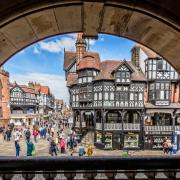Chirk Castle, completed in 1310 by Lord Roger Mortimer de Chirk, stands just 10 miles to the south of Wrexham town centre. The castle was one of several medieval Marcher fortresses constructed along the Welsh-English border under the instructions of King Edward I. The purpose of Chirk Castle and other fortresses along the border was to ensure the control of the Welsh by English rule.
In 1282, King Edward I defeated Welsh prince Llywelyn ap Gruffudd and created the new Marcher Lordship to become known as Chirklands. The monarch rewarded Roger Mortimer who had served faithfully in two wars against both the Scottish and Welsh by granting him the Chirklands.
The castle rose from the earth creating a fortress of considerable size and stature, and such importance that the king visited the site during construction. Built upon a high escarpment its location was ideal for controlling the region and monitoring trade along the Welsh-English border.
The main architect for the castle is most likely to have been Master James of St George, known for his work on other castles in the area including Harlech, Beaumaris and Caernarfon.
Chirk guarded the entrance to the Ceiriog Valley and was the administrative centre for the Marcher Lordship of Chirkland. In 1593, the castle was bought by Sir Thomas Myddelton for the princely sum of five thousand pounds. Myddelton then spent a great deal of money improving the landmark, building a new north range and adding state rooms. This was done with the intention of making the castle his family home, although, he chose to spend much of his time living in the county of Essex.
One of the interesting defensive features of Chirk Castle is the walls, many of which are five metres thick, making them almost indestructible. For at least the next 400 years the Myddelton family retained ownership of the castle using it as their main family residence. The castle we see today still looks magnificent with the colour of the stone blending in with the Welsh landscape. At the time of construction, it is most likely the outer walls would have been lime-washed making the white structure especially prominent from a distance.
In 1910, a lease was arranged between the Myddelton family and Thomas Scott-Ellis, the eighth Lord Howard de Walden, who had long held a passion for the building. He held lease right until 1946 when he returned to his own Scottish estates, dying there the following year. In 1981 Chirk Castle was transferred from the Myddleton family to the National Trust and is open to the public.
A particular point of interest is the section of Offa’s Dyke that passes just 200 metres beyond the wall of the castle. The famous hand-dug bank and ditch was constructed during the 8th century under the command of King Offa, to divide his kingdom of Mercia from rival kingdoms in Wales and stretches some 177 miles.
You can view many of my local history films featuring historical locations around Cheshire and beyond by visiting my history channel, youtube.com/@Tvpresenter4history.
Look out for
Stunning arched gateway into the castle
Beautiful landscaped gardens surrounding the castle
Section of Offa’s Dyke running close to the castle walls



























